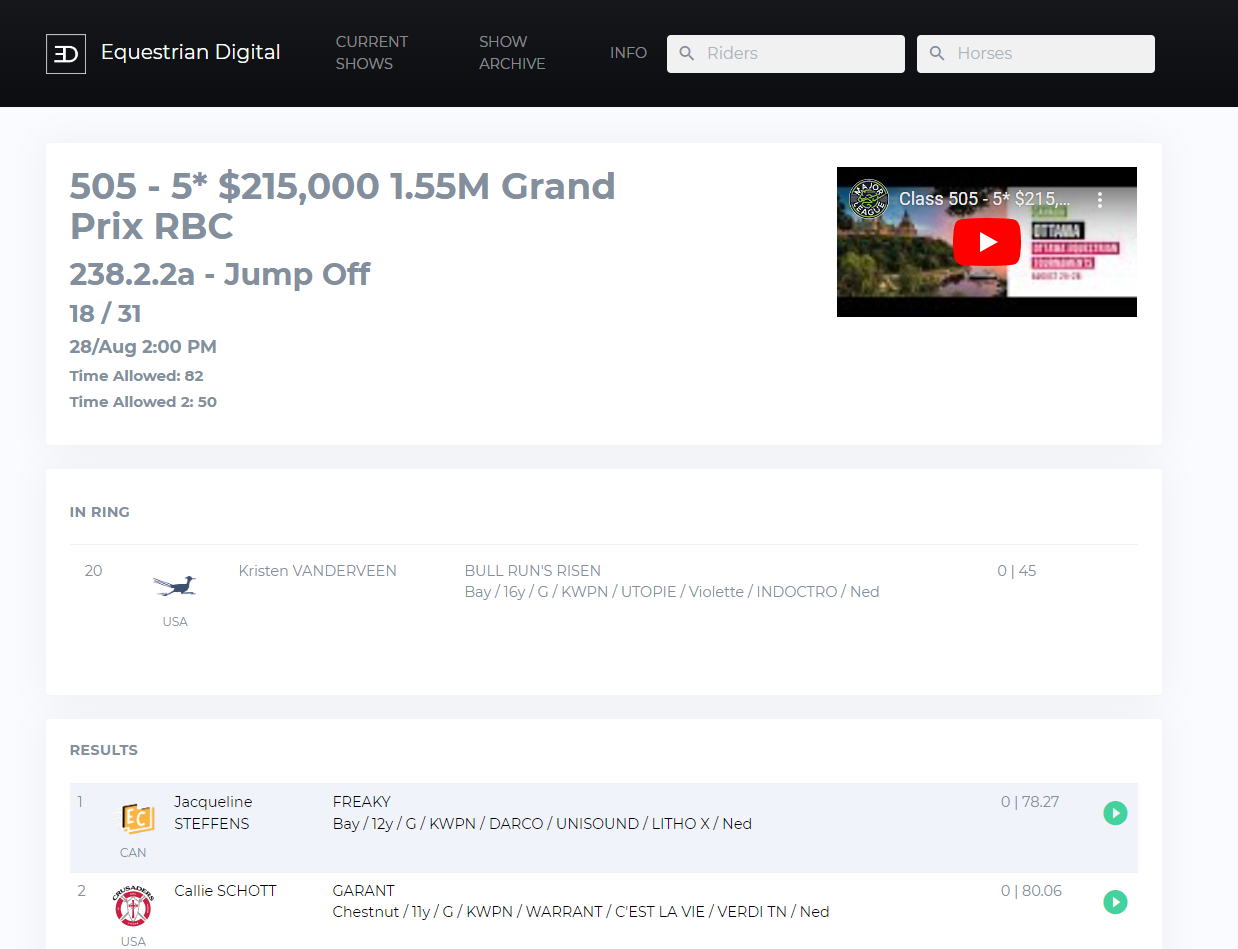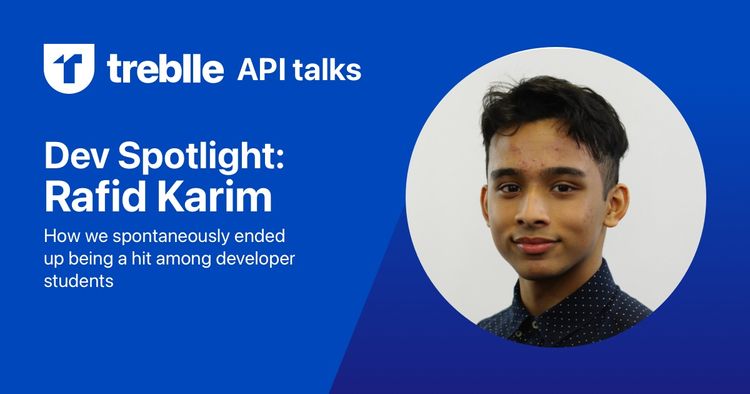Treblle API Talks is a series of interviews we did with our users. We talk about APIs in general, API observability and how Treblle helps them gain much needed context on how their API is performing.
In today’s edition of Treblle API Talks we bring you a conversation we had with Alejandro Lancaster-Jones, the General Manager of Equestrian Digital.
Alejandro is originally from Guadalajara but we caught him while he was “vacationing” with his family in Houston. He and his team actually had a few events in the States, specifically in Lexington Kentucky with several more events planned in Portland and Traverse City (Michigan). The full list of international events covers shows in Oregon, California, Michigan, South Carolina, Texas, Toronto, Ottawa, Guadalajara, Monterey and San Miguel de Allende, Colombia, Uruguay, and Guatemala. They also service other national-level events.

We asked Alejandro to share how they started…
“So, in the beginning we were in the e-commerce business, doing websites, and for these purposes we mostly used Magento. We worked with big retailers that had a lot of shops all around the country. Our revenue was generated by charging them let’s say a bigger fee that was not meant for smaller businesses. That was the core business of our company in the beginning.”
How did they end up doing business for horse shows?
As Alejandro’s wife does horse riding, he started going to horse shows and noticed that everything was done through spreadsheets, like all the administration. And while people are at the horse show they usually don’t know what’s actually going on, because there’s a judge with a microphone who calls out the scores as they go, but it’s very hard to keep track of everything.
“Each competition is called a class. So you may have a class with 50 horses so it’s impossible to remember the results and scores of each horse. The only thing you might know is who's in first place because the judge will keep calling the first place, but the rest is pretty hard to follow.”
His wife started working at horse shows, and was looking for better tools to keep track of everything so she hired a few software developers who started doing some things for the back-office side of business, in order to start replacing the spreadsheets. At that time, Alejandro was doing marketing for brands from the fashion industry, soon became independent and founded Vende, the company that would eventually become Equestrian Digital. He started helping his wife with that software problem she had, and soon he had those few software developers working at his office. In the beginning, the idea was just to help his wife, but soon other shows and clubs got interested in the solution they were working on. They realized they could rent the software out to others. At that point, their software became a cloud service, and more as a SaaS product.
One after another, new clients just started coming in. Then they started doing live results and realized they could put it on the website so the next logical step was developing a mobile application that could encompass everything.
“After the app went live, the people got really interested in it. Soon after that we started doing graphics for video boards, videos and streaming. At that point we started doing more and more shows which started generating customers in the United States.”, said Alejandro.
They don’t just do horse competitions in general, they do something very specific which is show jumping. Alejandro mentioned that this is a super niche market for which he didn’t even know existed before they started doing it. Their hyper specialization in it made them super efficient. Why? Because in the US their clients (prior to starting to work with them) had several different providers like one doing the website, one doing the back-office software, another doing live streaming, another doing scoring etc. And the integration of all those companies was extremely inefficient, and that’s where Alejandro and his team recognized the opportunity to optimize all those processes. Also, developing software in Mexico and bringing it to the USA was much more convenient for their US customer.
“Thanks to our efficiency, our growth came naturally so there was no need for a dedicated sales team. We are not sales people so we decided to put our focus on developing the product so we can have easy sales once we go to a customer. At the moment, our software is being used in Canada, USA, Mexico, Panama, Salvador, Venezuela, Argentina, Guatemala, Colombia."
How does their software work you wonder?
It’s a pretty straightforward process done through a few simple steps.
The first step is for a customer to create a show on the platform. So setting the date, location, registering the competition, adding the cover image etc.

After that, they go live for their online entries. At that point the audience (or rather, the competitors) go to the website, register and at that point they pay the reservation fee which goes through Stripe. Note that Alejandro and his team were primarily using the Chase bank but were experiencing some problems with it so they had to switch to Stripe.
By the time they’re doing their reservations, Equestrian Digital is already connected to both National Federations and International federations so once they type the number of the horse, immediately Equestrian Digital gets the information back from the federations. Alejandro mentioned that the US Equestrian Federation has the best API he has ever seen in terms of performance. It’s extremely fast. He even tried to discover their secret sauce but without success. :)
“Everything that’s money related is super important to us so when we have errors for which we don’t know what’s going on, that’s a problem. What we had to do with Chase is to start recording internally all the outgoing and ingoing logs so we could look at them more closely. From the performance side of things this is super inefficient. With Stripe we never had to do that. That’s just one of the examples where we struggled, as you can have a great front end and infrastructure but if you have an error and you can’t fix it quickly it all just goes to hell.”, said Alejandro.
Alejandro is one of those marketing people who actually also has experience in coding so we asked him to share a bit more on that part.
“So, I was doing programming as a teenager, doing websites and earning my lunch money. I love data, and I was always using a lot of spreadsheets, so I realized that Excel (even though it’s great) has some limitations. Especially with large data sets.
That’s when I started using databases and PHP.
I can do some programming, understand the databases and flows, so I would say that I understand the basics pretty well.”
And how big is your team at the moment?
“Well, currently we have 3 full time developers, 3 colleagues who are taking care of logistics and a bunch of people working at events.”
Alejandro also shared with us what tech stack they use at Equestrian Digital.
“It’s mostly PHP (for our basic API with no framework) and MySQL which holds 99% of our information on the back end side. We are exploring FuelPHP but will probably move to something different. We’re also evaluating Laravel, even Node but I’m not the biggest fan of it. That’s for our API.”
And what about their mobile app and website?
“It's Firebase and Firestore database for real time data. We push everything through our API. We grab the information from MySQL, we kind of warm it up, and send it to the Firestore. So when we have a big competition, when we have thousands of people using our website or app, it doesn’t touch our servers.”
Alejandro mentioned that it is a bit of a hassle to store the information in two different places, but performance-wise it’s avoiding entirely what could be potentially a huge problem, and they don’t have to downsize and grow their servers additionally.
On the server side they use DigitalOcean which is the friendliest for them at the moment. As he said, they don't have a DevOps team and they don’t need the best performance in the world, just something that is good enough for them.
After we got to know Alejandro better, and got more information on his business, we touched upon how he found out about Treblle and how they use it at Equestrian Digital.
“Well, we knew that we had this big blind spot with what’s going on on our system. We had it happen a couple of times with DigitalOcean - the communication between the PHP API and the database got super slow (it took from 3 to 5 seconds per request), and we didn’t learn about it until someone complained about it, but at that point it was just too late.
I knew that the AWS API Gateway existed so I started to work with that. I set it up and it was working but the question was how do I get the information and it turned out that if you want to get like a graph or just a list of your endpoints with response time it’s like a huge project. And I was like no I don’t want to work more hours on this, I just want to get the information so we can fix problems, hopefully, before they actually become a problem. So after wasting a lot of time on the API gateway, I was like there has to be a simpler solution to this.
I never used Reddit that much for work, but I started using it more and more because I was sure that there has to be an API conversation going on there. I started searching for terms like API monitoring, API tools, and there was a post, I believe from someone from your team, I clicked on it and I ended up at Treblle’s website.
I honestly don’t know who your competitors are because I couldn’t find anything. It looks like there’s a bunch of things you can work on and have this huge platform which is great, but for a smaller team like ours, I couldn’t find any information that could be useful for us. Honestly, I just wish it would have been easier to get to you so I wouldn’t have done all the stuff with AWS. Instead of that I could have just run a few lines of code on Treblle and see all that data flow in.
I see all the information flowing and I have a bunch of ideas on things that could be very useful. I believe that anyone who has a system like ours where we have a database, or even if you’re serverless and you just want to monitor what’s going on - seeing what’s going on, having a look in real-time at the stream of events happening is extremely useful.”
Alejandro also mentioned a few things he would like to see in the future on Treblle.
“I would love to see more graphs that would kind of say like - the high is bad, the low is good - so a simple and easy way to understand what’s going on.”
At that moment Alejandro didn’t know that we’re actually working on Treblle 2.0 where he will be able to create his own dashboard view with lots of different graphs in the shape of widgets.
“So from our side of things we look mostly at two things - errors and performance.
In a nutshell that’s all we need to know at this stage. So with more visual presentations like graphs it would be amazing.”
We asked Alejandro how was his first impression of Treblle, how easy it was for him to understand it and is there anyone else from his team who is using the platform.
“Yeah, absolutely. By the time I found out about Treblle our problem with DigitalOcean was already fixed. But there was an error that I noticed - PHP money_format function which is now deprecated. So it’s not a big issue, it’s more of a warning but if it weren’t for Treblle I don’t think I ever would have noticed that.
“I actually added the rest of the team to Treblle. We’re thinking about having someone who’s responsibility will be solely the API. Until now everyone’s been like full stack so now we’re gonna have an API guy. I want to go in Treblle and see there’s no errors and that everything is working fine.
That’s how I’ll know that the team is doing a good job. Until now, whenever we talked about how our API is doing, it was always too subjective. The question is how do we measure it and that has to be very objective. And now with Treblle we will always know how healthy our API is.”
Conclusion
The discussion we had with Alejandro was pretty interesting for us to understand how smaller teams are utilizing Treblle in their work.
In the case of Equestrian Digital, it’s all about tracking errors, performance and understanding the health of their API. And that’s just a part of what Treblle offers to its clients.
With the Treblle 2.0 version launching this fall, our users will get an even more detailed, more structured and visually appealing system that will further help them in developing APIs of the highest quality.
And that’s what Treblle is all about - helping you to deliver the best possible APIs, and API based solutions to the World!
Like always,
Stay in tune with your APIs!






